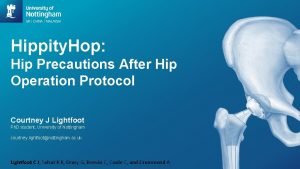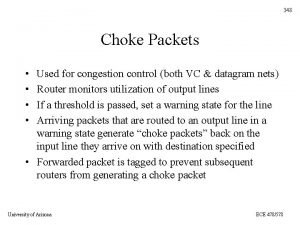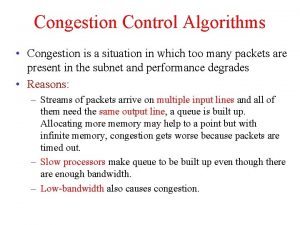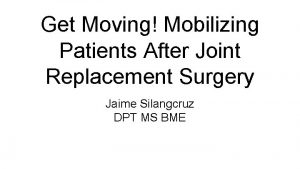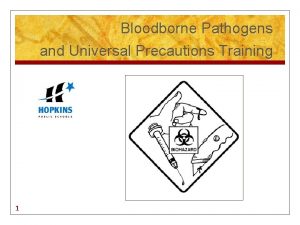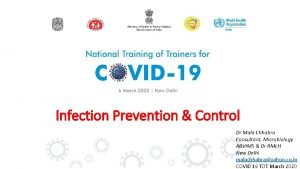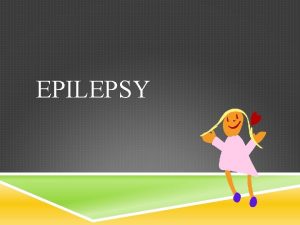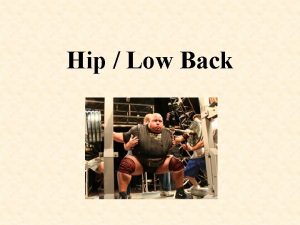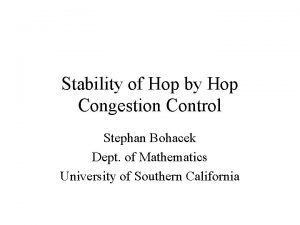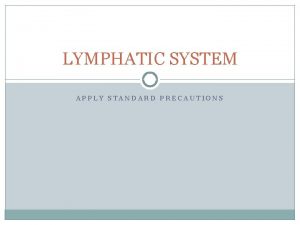Hippity Hop Hip Precautions After Hip Operation Protocol









































- Slides: 41

Hippity. Hop: Hip Precautions After Hip Operation Protocol Courtney J Lightfoot Ph. D student, University of Nottingham courtney. lightfoot@nottingham. ac. uk Lightfoot C J, Sehat K R, Drury G, Brewin C, Coole C, and Drummond A

Total Hip Replacement (THR) • Surgical treatment considered when the hip joint becomes damaged and causes persistent problems • Effective method to relieve pain, improve functional ability, and quality of life (Qo. L) • >83, 000 performed in 20151 • Dislocation recognised complication with incidence rates 1 -15%2 1. National Joint Registry, 2016; 2. Resptrepo et al. , 2011

Hip Precautions • To protect new joint and ↓↓ risk of dislocation Hip precautions Avoidance of specific movement 6 weeks Impact on daily life

Hip Precautions • Although routinely provided there are large discrepancies in the provision of hip precautions • Movements to avoid • Length of time to follow • Reasons for teaching • Equipment provision Drummond et al. , 2012

Hip Precautions • Although routinely provided there are large discrepancies in the provision of hip precautions Adduction Flexion Movements to avoid Internal/external rotation Drummond et al. , 2012

Hip Precautions • Although routinely provided there are large discrepancies in the provision of hip precautions 6 weeks Drummond et al. , 2012 Length of time to follow 12 weeks

Hip Precautions Smith and Sackley, 2016

Hip Precautions • Although routinely provided there are large discrepancies in the provision of hip precautions OT practice Surgical approach used Surgical opinion Reasons for teaching Team decision Hospital policy length of stay Evidence based Drummond et al. , 2012

Hip Precautions • Although routinely provided there are large discrepancies in the provision of hip precautions Chair / bed raisers Raised toilet seat Dressing aids Equipment provision Perching stools Long handled reachers Drummond et al. , 2012

Hip Precautions Smith and Sackley, 2016

Literature Review • Current research is equivocal, with conflicting evidence Not needed Dislocations occur due to undesirable movements that cannot be avoided 1 1. Gromov et al. , 2015. 2. Smith et al. , 2012. Long term use Counselling patients to avoid bending and to be vigilant during functional transfers 2

Literature Review Hip precautions = ↓ • No additional benefit for ↓ ↓ dislocation rates

Literature Review • No additional benefit for ↓ ↓ dislocation rates Study Dislocation rates (n/total (%)) Hip precautions No hip precautions Ververeli et al. , 2009 0 / 43 (0%) 0 / 38 (0%) Peak et al. , 2005 1 / 152 (0. 66%) 0 / 151 (0%) Barrett et al. , 2013 1 / 44 (2. 3%) 0 / 43 (0%) Duwelius et al. , 2007 0 / 43 (0%) Khan et al. , 2006 4 / 100 (4%) 0 / 100 (0%) Mikkelsen et al. , 2014 2 / 146 (1. 4%) 6 / 219 (2. 7%) Barnsley et al. , 2015; van der Weegan et al. , 2016

Literature Review Hip precautions = ↓ • No additional benefit for ↓ ↓ dislocation rates • Slower return to ADLs

Literature Review • Slower return to ADLs Ververeli et al. , 2009

Literature Review • Slower return to ADLs Peak et al. , 2005

Literature Review Hip precautions = ↓ • No additional benefit for ↓ ↓ dislocation rates • Slower return to ADLs • ↓↓patient satisfaction

Literature Review • ↓↓patient satisfaction Percentage (%) of patients who were satisfied with the pace of their recovery Peak et al. , 2005 Hip precautions No hip precautions 74. 3% 89. 4%

Literature Review Hip precautions = ↓ • No additional benefit for ↓ ↓ dislocation rates • Slower return to ADLs • ↓↓patient satisfaction • Sleep deprivation

Literature Review • Sleep deprivation 68. 4% patients in restricted group and 65. 6% patients in unrestricted group rated sleeping fully supine “uncomfortable” Peak et al. , 2005 ‘Sleep deprivation leads to increased anxiety and decreased satisfaction’ O’Grady et al. , 2003

Literature Review • Sleep deprivation 14% patients in unrestricted group began side-sleeping on night of surgery Significant differences in side-sleeping were noted at all follow-up time periods Peak et al. , 2005

Literature Review Hip precautions = ↓ • No additional benefit for ↓ ↓ dislocation rates • Slower return to ADLs • ↓↓patient satisfaction • Sleep deprivation • Significant £

Literature Review • Significant £ Cost savings of $655 … abduction pillow ($120) elevated toilet seat ($65) elevated chair ($955 to purchase, $15/day to rent) Peak et al. , 2005 Therapy time per patient (minutes) Mean (Range) Face‐to‐face contact Non‐patient contact 139. 72 (25 ‐ 540) 73. 15 (0 – 48) Drummond et al. , 2012

Literature Review Hip precautions = ↓ • No additional benefit for ↓ ↓ dislocation rates 1 • Slower return to ADLs 2 • ↓↓patient satisfaction 3 • Sleep deprivation 4 • Significant £ 5 1. Barnsley et al. , 2015; van der Weegan et al. , 2016 2. Ververeli et al. , 2009; Peak et al. , 2005 3. Peak et al. , 2005 4. Peak et al. , 2005; O’Grady, 2003; 5. Peak et al. , 2005; Drummond et al. , 2012

Literature Review • Strong opposing clinical opinions • Main difficulties in evaluating key literature: 1. Lack of robust methodology 2. Underpowered studies 3. Focus on dislocation

Research Aims Hippity. Hop 1. To compare outcomes of hip precautions vs. no hip precautions 2. To explore patients’ experiences of the regimes 3. To explore staff members’ perceptions of the service 4. To assess the costs of providing each regime

Study Design Impractical – service based Unrealistic provision RCT Potential for widespread contamination and protocol infringement Number of participants required to demonstrate a difference would be very large

Study Design Using a local Trust who are moving to a no precautions model of care as an opportunity to model the study around this service change Before After

Intervention ‘Routine’ (previous) treatment ‘New’ treatment strategy ‐ Hip precautions taught ‐ Patients encouraged to move as they are able ‐ Patients provided with ‘safe height’ ‐ Equipment routinely provided ‐ Equipment only provided to those who require it

Sample Size Treatment regimes Recruit = 342 participants (171 per group/ treatment regime) • Pre-defined margin of equivalence = 0. 5 SD • Confounding factors • 25% attrition rate Interviews Recruit = 40 participants (20 staff & 20 patients) • Sufficient diversity

Population and Recruitment • Elective THR patients Inclusion Exclusion Aged ≥ 18 years Do not speak or read English Elective primary THR Revision or ‘complex’ surgery Provide informed consent Dementia • Approached at preoperative assessment

Outcomes Pre-op Baseline Surgery Oxford Hip Score (pain and function) Qo. L ADLs mood 1 week 6 weeks 3 months sleep satisfaction dislocation Sample of cohort equipment time

Qualitative Interviews • Sample of patients from phase one and two, and orthopaedic staff Patient inclusion Participated in cohort study Staff inclusion Provide care to patients undergoing THR • Selected using maximum variation purposive sampling • Interview guidelines developed as study progresses

Results To date … Phase One 304 letters sent out 302 approached 182 consented 9 non returners 173 baseline completed 8 withdrawn 3 late returners 162 baseline for analysis 8 cancelled surgery 9 unfit for surgery

Results 145 baselines and surgery Phase One / Two Phase One 27 baselines complete 4 missed 6 to contact 118 baselines complete 17 one week complete 3 missed 10 awaiting return 115 one week complete 8 to send out 2 awaiting return 1 non returner 4 non returners 112 six weeks complete 23 awaiting return 20 to send out 1 non returner 74 three months complete 8 six weeks complete

Results To date … Phase Two 84 letters sent out 62 approached 42 consented 17 baseline completed

Next Steps Treatment regimes Recruitment ends = February 2018 Interviews Recruit: • 10 clinical staff (November 2017 – January 2018) • 10 patients (January 2018 – May 2018) Cost Assess 10 patients

Thank you Courtney J Lightfoot courtney. lightfoot@nottingham. ac. uk Courtney. JLight

Literature Review Key reviews Key papers 1. Sharma et al. , 2009 1. Talbot et al. , 2002 2. Barnsley et al. , 2015 2. Peak et al. , 2005 3. van der Weegan et al. , 2016 3. Restrepo et al. , 2011 4. Smith et al. , 2016

• Peak et al. , 2005

• Drummond et al. , 2012
 A hip a hop a hippity hop
A hip a hop a hippity hop Hip to the hippity hop
Hip to the hippity hop Old school hip hop quiz
Old school hip hop quiz Poem about hip hop
Poem about hip hop The squirrel poem summary
The squirrel poem summary Standard precautions and transmission-based precautions
Standard precautions and transmission-based precautions Hop by hop choke packet
Hop by hop choke packet Choke packet in congestion control
Choke packet in congestion control Hop to hop
Hop to hop Principles of congestion control
Principles of congestion control Hop on hop off delhi
Hop on hop off delhi Hop by hop choke packet
Hop by hop choke packet No bending lifting twisting
No bending lifting twisting After me after me after me
After me after me after me John 14 1-3
John 14 1-3 Bronkse
Bronkse Father of hip hop
Father of hip hop São elementos constituintes da dança
São elementos constituintes da dança Curiosidades do freestyle
Curiosidades do freestyle Hip hop questions to ask
Hip hop questions to ask Spreschen
Spreschen Hip hop prezentace
Hip hop prezentace O hip hop tem sua filosofia propria com valores
O hip hop tem sua filosofia propria com valores History of rap music timeline
History of rap music timeline Hip hop presentation
Hip hop presentation Hip hop for php
Hip hop for php Hip hop php
Hip hop php Flocabulary shakespeare is hip hop
Flocabulary shakespeare is hip hop Hip hop music magazines
Hip hop music magazines Hip hop turkeys
Hip hop turkeys Shakespeare flocabulary quiz answers
Shakespeare flocabulary quiz answers Universal precautions in operation theatre
Universal precautions in operation theatre First hop redundancy protocol
First hop redundancy protocol In the ssl record protocol operation pad_2 is
In the ssl record protocol operation pad_2 is Precautions when moving materials manually
Precautions when moving materials manually Precautions in specimen collection
Precautions in specimen collection Universal precautions training
Universal precautions training Transmission based precautions meaning
Transmission based precautions meaning Chapter 16 infection control and standard precautions
Chapter 16 infection control and standard precautions Definition of standard precautions
Definition of standard precautions Seizure precautions bed rails
Seizure precautions bed rails Precautions for hot weather concreting
Precautions for hot weather concreting

